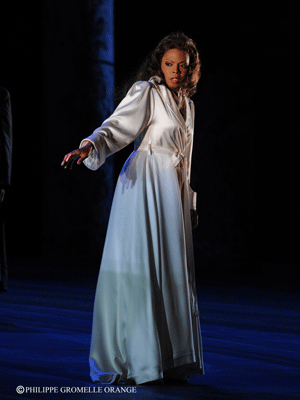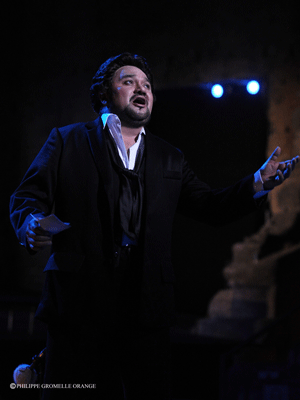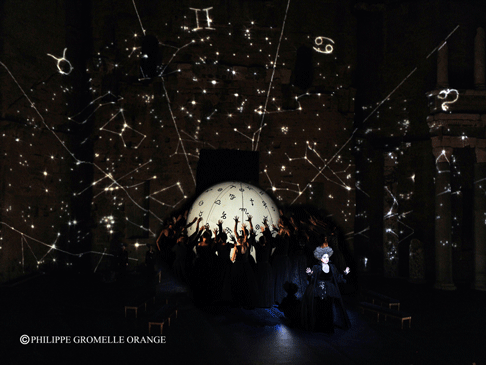Un ballo in maschera was maybe the first opera to be strikingly if arbitrarily translocated in place and time — Verdi first moved his story and characters from Stockholm to Pomerania, then from there to New England, all this for political rather than dramaturgical reasons! The raisons d’Ètat for such moves and their ramifications are in fact quite theatrical (censors and lawsuits), in fact far more so than what small theatricality can be eked from the opera.

There is however a lot of singing that results from a reworking of an old libretto by EugËne Scribe about the assassination of Gustavo III of Sweden. Scribe is the famed creator of the “well-made play” which meant back in the early 19th century construing a series of emotional moments into a reasonable flow of happenings. But such reasonable intention can become an end in itself, and Verdi’s ballo seems such an exercise.
Such lack of dramatic sincerity was evident in Claude Auvray’s production for the ChorÈgies d’Orange. There was no telling where or when the action takes place, maybe back in Stockholm though the characters use their Italian names from the Pomeranian version. The king and his courtiers were in modern business suits, cell phones at their ears, the decor was a sort of 19th century theatrical drape painted on the stage floor, the masked ball was 18th century powdered wigs. Riccardo (identified as Gustavo on political posters) was enveloped in a massive nordic looking mantle from time to time, Ulrica and her acolytes were in big black gowns with weird gray fright wigs.
It is big at Orange, the stage a few hundred feet wide, its pit (orchestra in Latin) is correspondingly huge and for this ballo housed the accomplished Orchestra National Bordeaux-Aquitaine with a fully symphonic contingent of strings. French conductor Alain Altinoglu, well known to international opera audiences through Live in HD from the Met, responded with ample tempos that stressed size rather than intensity.

Voices were of smaller scale, Riccardo, that is Gustavo, was Mexican tenor RamÛn Vargas, one of the more musically accomplished tenors who frequent international stages. He was in fine voice and delivered a well executed performance. His voice remains sweet and supple without the force of production one might expect from the King of Sweden, particularly on a Roman proscenium.
Amelia was young American soprano Kristen Lewis (born in Arkansas) who went directly from the University of Tennessee to Vienna where she has blossomed into a proto-Verdi soprano who also sings Mimi. She possesses a voice of pure, sweet sound, of ample force that she uses in high Italianate style. Plus she has mastered natural looking acting gestures appropriate to big singing. It all seemed the Cinderella moment of an important career until she disappeared at the end into her huge white ball gown and remained a mere Mimi.
Renato was bespectacled Italian baritone Lucio Gallo notable as the first Italian singer to be invited to the Bayreuth Festival (as Lohengrin’s Telramund in 2010). In Orange just now he apparently was seduced by the grandness of antiquity as he attempted volumes beyond his capacity and lost all possibility of actually forming words. He accepted his hueÈs (boos) with dignity.
Oscar, French soubrette Anne Catherine-Gillet took the stage from the start and made Verdi’s opera about the page (it was she who supported Gustavo during his dying moments, Amelia showed no reaction at all discreetly distanced on the arm of her husband, the murderer). French mezzo soprano Sylvie Brunet-Grupposo created an Ulrica of little distinction (by the way it was in 2005 that she added the Sicilian surname to her French one when she discovered the identify of her father).
Singing and mise en scÈne at Orange is about size, not about detail. Over the years the various musical and staging techniques have become apparent, though the secret of the impeccable ensemble of chorus with the pit remains a mystery (the combined choruses of the operas of Nice, Nantes-Angers and Avignon number well more than a hundred). Staging however is done to recognized formulae that have proven effective over the decades, notably choristers pour onto the stage from both sides in colorful costumes to make scenic effect given that any real scenery would compete with the magnificent Roman stage wall and no one would want that. Principals remain down stage center and sing.

There is always a coup de thȂtre event at the finale, here projections brilliantly lighted the huge Roman stage wall with its original sculptural detail. But the wall slowly darkened from the top down during the several minutes it took Riccardo aka Gustavo to expire. Magnificent is the word. The scenography was by Rudy Sabounghi and the exceptionally moody lighting by Laurent Castaingt, artists primarily active in the south of France and Monaco).
Light sprinkles of rain stopped the show from time to time but did not dampen the enthusiasm of the 8000 or so spectators. The stage crew, apparently unprepared for even the slightest precipitation, resorted to using toilet paper, a Calixto Bieito touch, to wipe the stage floor.
Michael Milenski
Cast and production information:
Amelia: Kristin Lewis; Ulrica: Sylvie Brunet-Grupposo; Oscar: Anne-Catherine Gillet; Riccardo: RamÛn Vargas; Renato: Lucio Gallo; Samuel: Nicolas Courjal; Tom: Jean Teitgen; Silvano: Paul Kong; A judge: Xavier Seince; A servant: Bo Sung Kim. Orchestre National Bordeaux-Aquitaine and the choruses of the operas of Nice, Avignon and Angers-Nantes, plus the Compagnie FÍtes Galantes conducted by Alain Altinoglu. Mise en scËne: Jean-Claude Auvray; ScÈnographie: Rudy Sabounghi; Costumes: Katia Duflot; Lighting: Laurent Castaingt; ChorÈgraphie: BÈatrice Massin. Le ThÈ‚tre antique d’Orange, August 6, 2013.
image=http://www.operatoday.com/Orange251.gif
image_description=The Roman Theatre in Orange [Photo © Philippe Gromelle Orange]
product=yes
product_title=Un ballo in maschera at Orange
product_by=A review by Michael Milenski
product_id=Above: The Roman Theatre in Orange
Photos © Philippe Gromelle Orange